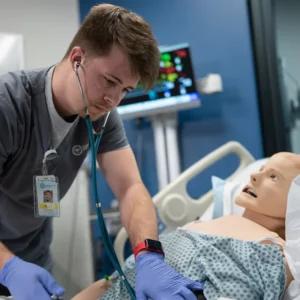Have you ever wondered what it’s like to work as a medical laboratory technician? To find out more, we spent time with a Carrington College Medical Laboratory Technician (MLT) program [1] graduate at St. Luke’s Medical Center in Phoenix, Arizona. https://youtu.be/QS97tc_7DqQ Chad has been at St. Luke’s for about a year and a half. He worked as a phlebotomist during his first year at the hospital, while he finished the two year [2] MLT program at Carrington. He graduated in April 2016 and moved to his current job as a medical laboratory technician in the Microbiology department.
What is Microbiology?
The first thing to know is microbiology is very important. The dictionary definition of microbiology [3] is ‘the branch of science that deals with microorganisms’. Chad’s supervisor, Kevin, is the Microbiology Lead. He runs the Microbiology department at St Luke’s and he told us what his department does every day. “We isolate and identify disease-causing pathogens and confer with physicians as to the best course of treatment. Other departments are more crucial to blood counts, white counts, what’s going on at that minute in the patient. We’re helping the infectious disease physicians treat the patients,” said Kevin. Chad’s department does microbiology work for other hospitals too. “When we get here first thing in the morning we collect all the specimens that have shown up overnight from the other hospitals that we do microbiology with. We set up everything and we plate all the specimens. The media that we use, anything can grow in it, so we have to be very careful with what touches the media,” Chad explained. In microbiology terms, the word ‘media’ is the liquid or gel that supports the growth of microorganisms. In non-scientific terms it’s the ‘stuff’ that technicians place the specimens in to see what grows!
Would I Get to Use a Microscope?
When you think of a medical lab, you might think of people in white coats using microscopes, and that’s not too far from truth. Kevin explains why it’s an important tool in a medical laboratory. “The microscopes are used for Gram staining direct samples, to check culture growth on plates if you need to confirm what you’re seeing on the slide versus what you’re seeing on the plate. It’s used throughout the day, it’s a big part of the process.” A Gram stain, named for the guy that invented it, is a test that technicians perform on samples to check whether the patient has an infection. The result helps a physician know whether bacteria is causing the infection, and if so what type of bacteria is present.[4] “We are mainly just looking for whether it’s a Gram-positive bacteria or a Gram-negative bacteria. Your basic Strep and Staph species are Gram-positive, and E coli is an example of a Gram-negative bacteria,” explained Chad.
Providing Answers
Figuring out what’s wrong is a big part of helping people feel better. Medical lab technicians help physicians figure out what’s wrong by turning complex tests into answers. “A big part of Chad’s training at Carrington was getting to know the basics. When he gets here he’s not just reading it out of a book, he’s applying it. Repetition over and over and over again just ingrains it in your mind,” said Kevin. “You have to know the basics; for micro[biology] specifically, you have to know what Staph should look like, what Pseudomonas should look like, and you should know the accompanying bio-chemical tests that each of them should have. You should know what drugs are used to treat what type of infection,” added Kevin.
Critical Thinking is Important
Kevin likes working with Carrington College graduates because they have critical thinking skills and a solid foundation that they’ve learned in the classroom. “I’m looking for critical thinkers; I’m looking for somebody that can bridge the gap between what they’re taught in class, what they’ve learned out of books, and how to actually apply it in the real world.” Chad developed that solid foundation from working with his instructors at Carrington. “A lot of our instructors came in from hospital settings; they’re already medical lab technicians or medical technologists and they gave us a lot of hands-on information that they’ve done while they were out there in the job,” said Chad. So what are you waiting for? To learn more about the Medical Laboratory Technician program at Carrington College, click here.
[1] Important information about the educational debt, earnings and completion rate of students who attended this program can be found at carrington.edu/cc/mlt. [2] Not including breaks. Program length by weeks and admission requirements can be found here in the academic catalog. [3] https://en.oxforddictionaries.com/definition/microbiology [4] http://www.healthline.com/health/gram-stain#Overview1



